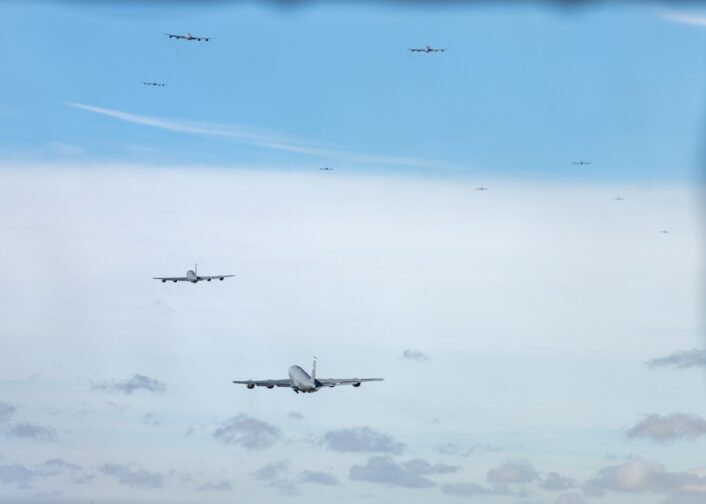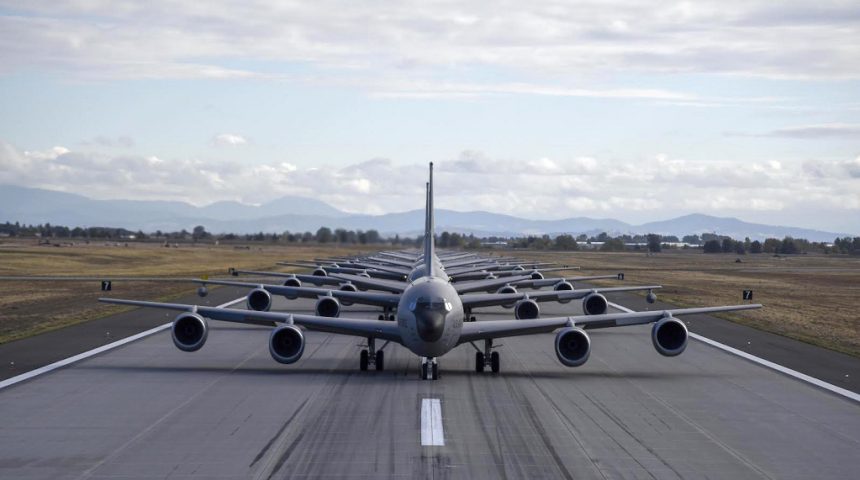The KC-135 MITO was part of a proficiency and readiness exercise to validate Fairchild’s maintenance generation and the ability to launch multiple aircraft in rapid succession.
On Sept. 29, 2021, the 92nd Air Refueling Wing successfully launched a 20-ship Minimum Interval Take-Off (MITO) mission from Fairchild Air Force Base, Washington.
According to the unit, this exercise was the largest KC-135 MITO training in the base’s history and was part of a proficiency and readiness exercise which sought to validate Fairchild’s maintenance generation and operational capabilities to launch multiple aircraft in rapid succession.
“We pulled off something historic yesterday,” said Colonel Craig Giles, 92nd Maintenance Group Commander. “Even more impressively, our maintainers generated 20 aircraft with no spares and then launched them all without a single line canceled. It would not have been possible without the hard work of the entire Fairchild team.”
Today we #MadeHistory with the biggest MITO at #TeamFairchild. Did someone say 20-jet take-off? Yea. We did that. 😎 #TrainLikeWeFight@AirMobilityCmd @usairforce @US_TRANSCOM pic.twitter.com/HtaCZNpTEV
— Fairchild AFB (@TeamFairchild) September 29, 2021
The exercise kicked off with an impressive “Elephant Walk”, as the 20 tankers lined up and taxied on the runway before the mass departure. The first aircraft took off at 10:06 a.m. (local time), as stated by 2nd Lt. Ariana Wilkinson, a spokesperson for the 92nd Air Refueling Wing. Then, the tankers launched in rapid succession in 15-seconds intervals, completing the departure of all 20 KC-135 exactly five minutes later at 10:11.
#DYK: A group of 20 units may also be referred to as a score.@TeamFairchild conducted its biggest minimal interval takeoff ever, with 20 KC-135 Stratotankers taking off from the flight line. #TankerThirstThursday
(📸 by Staff Sgt. Dustin Mullen) pic.twitter.com/0Rqx16ZYnr
— Air Mobility Command (@AirMobilityCmd) September 30, 2021
“From the top down, everyone was on point and ready to complete this mission. In Maintenance, we get the mission done — period. Our crew works around the clock to ensure the airworthiness of these 65-year-old plus aircraft.” said Master Sgt. Cody Haynes, 92nd Aircraft Maintenance Squadron flightline expediter. “Between the crew chiefs crushing it on the ground, the specialists responding to red balls [time-sensitive maintenance] during the aircraft launch, and the production team coordinating the maintenance actions, we made this a no-fail mission.”

Interestingly, at least 18 of the 20 KC-135s were trackable online thanks to ADS-B, which sparked curiosity among aircraft trackers and enthusiasts. The aircraft flew in a large formation, stacked every 500 ft from FL180 to FL275 for separation, before splitting in multiple groups. Multiple theories came up online for the reasons of this large formation, including bomber support and Joint Forcible Entry (JFEX) exercises, until the 92nd ARW released a statement and disclose the nature of this exercise.
There’s an 18th in the screenshot, but I ran out of characters.
62-3509 #AE0484
— Amelia (@ameliairheart) September 29, 2021
Ah! It’s not, the stack just has so many, they have them at 500 foot intervals such that it stretches from FL180-275! pic.twitter.com/wD76j0fbcY
— Evergreen Intel (@vcdgf555) September 29, 2021
5 groups now. And with the PNW weather being what it is, I would totally expect bombers to pass by or something as it is, of course, cloudy. pic.twitter.com/pXgvrwkE9L
— Evergreen Intel (@vcdgf555) September 29, 2021
The importance of exercises like this “Elephant Walk” and MITO departure has been explained multiple times in the past when we reported about them here at The Aviationist:
Generating multiple aircraft sorties can be a significant challenge for any flying unit. In fact, not all aircraft are available for the flying activity each day: some are involved in scheduled maintenance activities, others are grounded by minor or major issues while others on standby as spares. Then, there might not be enough aircrews to launch the aircraft, because of the working shifts, currencies, training activities, deployments, time-offs, etc.
Fairchild Air Force Base is the largest tanker base under the Air Force’s Air Mobility Command, home to a fleet of 63 KC-135s shared by the four squadrons of the 92nd and 141st Air Refueling Wings (the latter belonging to the Washington Air National Guard). The base is now one of the candidates, together with MacDill AFB, Florida, to replace its 65-years old KC-135 Stratotankers with the new KC-46 Pegasus tankers.









